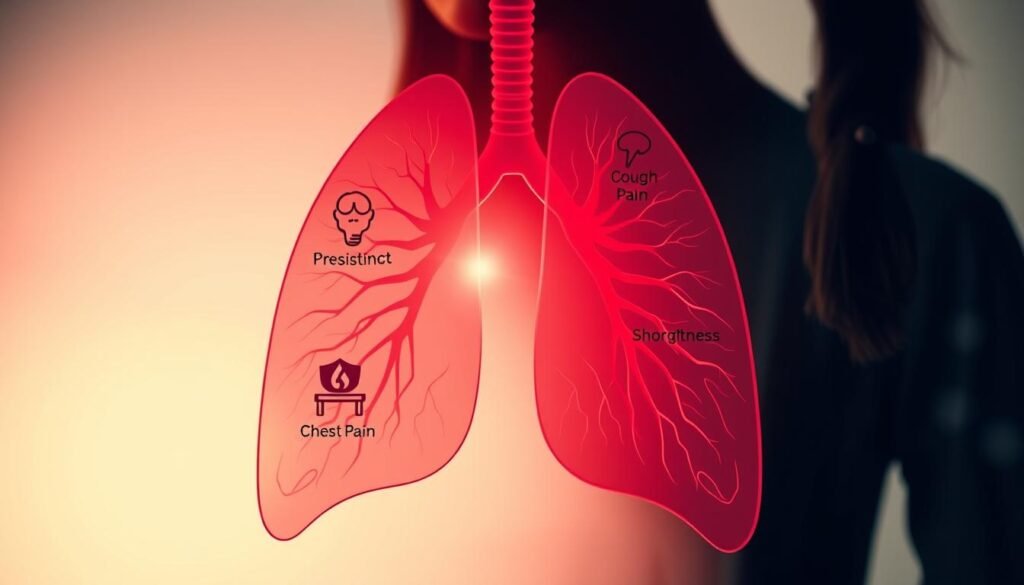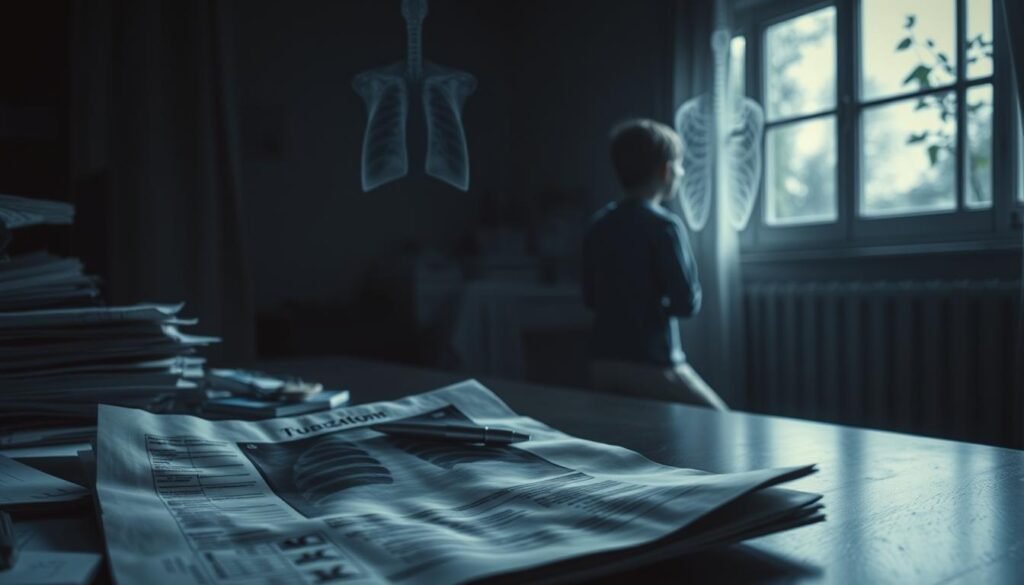Many teens get diagnosed with lung cancer at later stages than other age groups. The reason? They often wait too long to get checked by a doctor. Teen lung cancer is rare but can cause big health issues. Teens might ignore the signs until they’re really sick.
Teens are figuring out who they are and might not think much of health changes. They might think it’s nothing big. But paying attention to health is key. Knowing early signs of lung cancer can save lives. We need to teach our youth about this.
Key Takeaways
- Lung cancer in teenagers is often diagnosed at advanced stages due to delayed recognition of symptoms.
- Awareness of early warning signs can lead to timely interventions and improved outcomes.
- Adolescents often prioritize social and educational activities over health concerns.
- Symptoms such as persistent coughing and unexplained fatigue should not be overlooked.
- Health vigilance among caregivers and teenagers is vital for early detection of pediatric lung cancer.
Understanding Lung Cancer in Adolescents
Lung cancer is quite rare in adolescents, affecting about *1 out of every 2 million*. It makes up only *0.2%* of all pediatric cancers. Known as teenage lung carcinoma, it targets those between 10 to 19 years old. From 2000 to 2019, the U.S. saw only *301 cases* in this age group.
When it comes to who gets this disease, more girls than boys are diagnosed, with an average diagnosis age of *16 years*. Most patients, *80%*, are White while *14%* are Black. The survival rate is high, with *89%* of teens living at least a year after finding out they have cancer.
Risk factors for lung cancer in teens include genetics and being around harmful chemicals. Unlike in adults, smoking cigarettes isn’t a leading cause for them. Yet, chemicals from vaping and possibly marijuana use could be harmful. These might increase their cancer risk.
Much of the treatment for teen lung cancer involves surgery, with *80%* having part of their lung removed. The most common operation is a lobectomy. Besides surgery, some teens also undergo chemotherapy or radiation. It’s essential for families to discuss these issues. Understanding treatment options can help manage the disease better.
Why Early Detection Matters for Teenagers
Finding lung cancer early is crucial, especially for teens. It helps improve the chances of beating the disease. Teens and their families need to know the risks and signs of lung cancer early on.
Teens often miss out on regular health check-ups. This can lead to finding lung cancer too late, when it’s harder to treat. Teaching teens about the importance of spotting cancer early is key. This knowledge can lead to fast action and medical visits when needed.
Only a small number of lung cancers affect people under 35. But this fact shows that young people are not immune. Teens with lung cancer often have a better chance of improvement than older people with the disease. Catching it early can make a big difference.
Doctors and families need to look out for lung cancer signs in teens. Talking about the dangers of lung cancer in young people is important. It can lead to faster help and maybe even save lives.
Recognizing Common Symptoms of Lung Cancer
Lung cancer can often trick you, showing signs that are easy to ignore. It’s key to know the common symptoms of lung cancer for quick diagnosis. Teens might not spot the signs of lung cancer in youth right away. This delay can lead to worse health issues. A stubborn cough is a common sign, often mistaken for a cold or allergies.
Having chest pain when you breathe could mean lung trouble, not just growing pains. Feeling very tired for no clear reason and losing weight are also signs. These symptoms can get overlooked by teens who think they’re just busy or stressed. This makes them put off seeing a doctor.
Talking about lung cancer awareness is very important for young people and their families. It’s crucial to understand symptoms like constant coughing, chest pain, and feeling very tired are serious. Catching these signs early can lead to quicker help, which is vital to fight this sickness.
| Symptom | Description | Notes |
|---|---|---|
| Persistent Cough | A cough that does not go away. | Often dismissed as a cold or allergies. |
| Chest Pain | Discomfort or pain in the chest area. | Can be misattributed to muscle strain. |
| Unexplained Fatigue | Extreme tiredness without a clear cause. | May be overlooked due to busy lifestyle. |
| Weight Loss | Significant weight change without dieting. | Often alarming but ignored initially. |
| Difficulty Breathing | Shortness of breath during normal activities. | May be mistaken for physical exertion effects. |
Spotting these symptoms early can make treatment more effective. It shows why it’s so important for families to talk about health openly.
Lung Cancer Teenager: Key Warning Signs to Monitor
Finding out about lung cancer signs early is really important. Even though lung cancer in teens is rare, knowing what symptoms to look for can help catch it early. Here are some symptoms in young people that should not be ignored.
Unexplained Coughing and Chest Pain
If a cough doesn’t go away after a few weeks, it’s worrisome. This cough might be a sign of lung cancer. Chest pain that happens with coughing or laughing could mean something serious. It’s important to check these signs early for lung cancer.
Weight Loss and Loss of Appetite
When someone loses weight without trying, it’s a red flag. Not wanting to eat can also mean lung cancer is present. These signs should make one quickly seek a doctor’s opinion. Even a small change in how much someone eats can point to a problem.
Shortness of Breath and Fatigue
Feeling short of breath and very tired are worrying signs. If these happen during simple tasks or rest doesn’t help, lung cancer could be the reason. These symptoms are serious and need a doctor’s check-up right away.

| Warning Sign | Description |
|---|---|
| Unexplained Coughing | A cough lasting more than a few weeks; worsening cough. |
| Chest Pain | Persistent pain, especially while laughing or coughing. |
| Weight Loss | Significant weight loss without diet changes; loss of appetite. |
| Shortness of Breath | Breathlessness during normal activities; escalating fatigue. |
If you see any of these signs, getting help from a doctor is key. Catching it early can really help with treatment. For more details on lung cancer in young people, visit this link.
Additional Symptoms of Lung Cancer in Youth
Knowing the extra signs of lung cancer in youth is key for quick diagnosis and help. Young folks might show different breathing issues than the usual lung cancer symptoms. Spotting them early leads to the right medical help and care.
Coughing Up Blood or Rust-Colored Sputum
Seeing blood or rust-colored spit when coughing is alarming. It usually means something’s wrong with the lungs. This could be a sign of serious lung problems in teens, like cancer. Quick checks by a doctor are crucial for handling it well.
Recurring Respiratory Infections
Getting bronchitis or pneumonia over and over is a red flag. It’s not just bad luck with seasonal bugs. These ongoing infections could warn us of lung cancer in the young. It means there might be deep issues in the lungs needing a closer look.
Changes in Voice and Wheezing
Voice getting hoarse or changing is a heads-up for blocked airways. Wheezing suggests there’s swelling in the breathing paths. These issues could mean lung problems in youth, like cancer. Taking care of these signs quickly helps in better managing lung health.
Factors Contributing to Delayed Diagnosis
Many teens think they can’t get seriously ill, which leads them to ignore warning signs. This makes them less likely to seek medical advice early. Such attitudes create a gap in catching diseases early, like lung cancer in adolescents.
Doctors often don’t suspect lung cancer in young people quickly. This is because lung cancer is more common in older people. Not considering it early can delay the correct diagnosis, making treatment harder.
Teens are also busy with school and social life, which can make them put health last. They might think they can just push through any health issue. Not getting help when it’s needed can miss the chance for early treatment.

We need better ways for doctors and young patients to talk about health risks. Teaching teens about the importance of noticing and acting on health issues is key. It can help catch diseases like lung cancer sooner, improving chances of recovery.
| Contributing Factor | Description |
|---|---|
| Teen Perception of Health | Belief of being invulnerable affects the seriousness attributed to symptoms. |
| Healthcare Provider Bias | Cancers like lung cancer are often not considered in younger patients. |
| Social/Academic Pressures | Busy lifestyles reduce prioritization of health interventions. |
| Lack of Awareness | Insufficient education on symptoms leads to underreporting of health issues. |
Importance of Visiting a Doctor
It’s crucial for teenagers to know when to see a doctor. Persistent symptoms should not be ignored. Early action can lessen risks and improve outcomes, especially with diseases like lung cancer.
When to Seek Medical Advice
Teenagers need to look out for certain signs. If they notice things like:
- Unexplained weight loss
- Severe or persistent coughing
- Shortness of breath
- Chest pain
It’s time to see a doctor. Early check-ups can help catch lung cancer sooner. This means better options for treatment.
What to Expect During a Medical Evaluation
When being checked for lung cancer, doctors do a full review. They look at your health history and do a physical exam. Doctors might also need more tests, such as:
| Diagnostic Test | Description |
|---|---|
| CT Scan | Imaging to check for masses or abnormalities in the lungs |
| X-ray | Basic imaging to unveil lung-related issues |
| Blood Tests | To identify biochemical signals of potential cancer |
These steps help doctors figure out the problem. Getting started early is key to successfully treating the condition.
Screening for Lung Cancer in Teenagers
Lung cancer screening is often talked about for teenagers, but it’s rare in this age group. Even though it’s not usually suggested, some teens might need it based on their family history or if they’ve been around harmful things like pollution a lot. It can be helpful for these teens to get checked out early.
It’s important to know when it might be right for a teen to get screened. Knowing the symptoms and what increases the risk helps a lot. Parents and guardians should talk to doctors to see if screening is a good idea for their teen. They can look at the American Cancer Society guidelines for more info on who should get screened and how.
Usually, doctors use a special low-dose CT scan for screening. This scan takes very clear pictures of the lungs. Even though teens might not smoke, things like secondhand smoke or working in risky jobs can still affect them. Families should talk with doctors to decide the best way to keep teens safe from lung cancer risks.
Types of Lung Cancers Affecting Teenagers
Teenagers can get two main types of lung cancer. Knowing these types helps spot symptoms early and choose the right treatment. Non-Small Cell Lung Cancer (NSCLC) and Small Cell Lung Cancer (SCLC) are the most common in young people. Each type affects the patient differently.
Non-Small Cell Lung Cancer (NSCLC)
About 80% to 85% of lung cancers in teens are NSCLC. Within NSCLC, adenocarcinoma is often found, especially in teens who smoke. However, it can also appear in those who don’t smoke. It’s more common in girls and young people than other lung cancers.
- Adenocarcinoma: Found in smokers and non-smokers alike.
- Squamous cell carcinoma: Mainly linked to smoking, located in the middle of the lungs.
- Large cell carcinoma: Grows fast and is hard to treat, similar to SCLC.
Small Cell Lung Cancer (SCLC)
SCLC makes up about 10% to 15% of lung cancers in teens. It’s known for being very aggressive. It often spreads quickly, making early detection key to better treatment outcomes.
Teens rarely get other lung tumors like carcinoid tumors. There are also very rare cancers like adenoid cystic carcinomas and lymphomas. Knowing about these can help doctors and families provide the best care.
| Type of Lung Cancer | Prevalence in Teenagers | Characteristics |
|---|---|---|
| Non-Small Cell Lung Cancer (NSCLC) | 80% – 85% | Slow growing, various subtypes including adenocarcinoma and squamous cell carcinoma |
| Adenocarcinoma | Most common NSCLC | Seen in smokers and non-smokers; more common in females |
| Squamous Cell Carcinoma | Less common NSCLC | Linked to smoking; primarily found in the center of the lungs |
| Large Cell Carcinoma | Part of NSCLC | Grows quickly; similar growth rate to SCLC |
| Small Cell Lung Cancer (SCLC) | 10% – 15% | Aggressive growth; tends to spread quickly beyond the lungs |
| Lung Carcinoid Tumors | Rare ( | Generally slow growing |
Living with a Lung Cancer Diagnosis
Getting a lung cancer diagnosis when you’re young is tough. It deeply affects your feelings and mental health. It’s crucial to have strong support from family, friends, and counselors. These support systems help teenagers feel less alone and more understood. They bring comfort and a sense of family.
Support Systems for Teenagers
Support from others is key for teens fighting lung cancer. Being part of support groups helps. They can share stories and hardships in a safe place. This sharing helps them deal with their feelings and be strong. Parents, caregivers, and therapists offer comfort. They help teens manage the fear and stress of cancer. Meeting others in the same boat brings hope and helpful tips.
Resources for Patients and Families
There are many resources for young cancer patients and their families. They help with understanding lung cancer treatment and care. Websites and forums provide info on treatments and trials. Also, many groups offer health services. These tools help families cope better and make smart care choices.

Research and Treatment Advances in Pediatric Lung Cancer
Research into pediatric lung cancer is moving forward, opening new doors for treatment. Around 14,910 kids and teens in the U.S. might get cancer in 2024, making pediatric lung cancer research vital. Exploring targeted therapies, genomic profiling, and immunotherapy is changing how we deal with juvenile lung neoplasm.
There’s good news for young lung cancer patients thanks to the latest treatments. Targeted therapies now can attack specific genetic changes. One example is sotorasib (Lumakras™) which targets the KRAS G12C mutation in non-small cell lung cancer. Also, immune therapies, like checkpoint inhibitors, offer new hope beyond traditional treatments.
Knowing different treatment options helps families take an active role in their child’s health. Joining clinical trials can open doors to new therapies and help in pushing pediatric lung cancer research forward. This participation might increase chances for better survival rates in the long run.
Thanks to advancements, there’s been a big drop in cancer deaths among young people. Families should stay up-to-date with research and treatments. Making informed decisions can brighten the future for kids with lung cancer. As we continue to discover more, hope grows for these young patients.
Conclusion
Lung cancer is a big problem, especially for teenagers. Knowing about it can make a big difference. The conclusion on lung cancer in teenagers shows we need to teach kids and teens about the early signs. It’s important for young people, their families, and schools to keep an eye out and be informed.
Teaching teens about cancer helps catch it early. This can save lives. Doctors and families need to work together. They should focus on health education and spotting signs early. Case studies have shown, like ones about a rare cancer called invasive mucinous adenocarcinoma, finding cancer early helps a lot.
By talking more about lung cancer in teens, we can make it less scary. We also help teens feel stronger when facing it. We need ongoing research and plans that fit each young person’s needs. For more information, check out a case report about a teen with lung cancer.